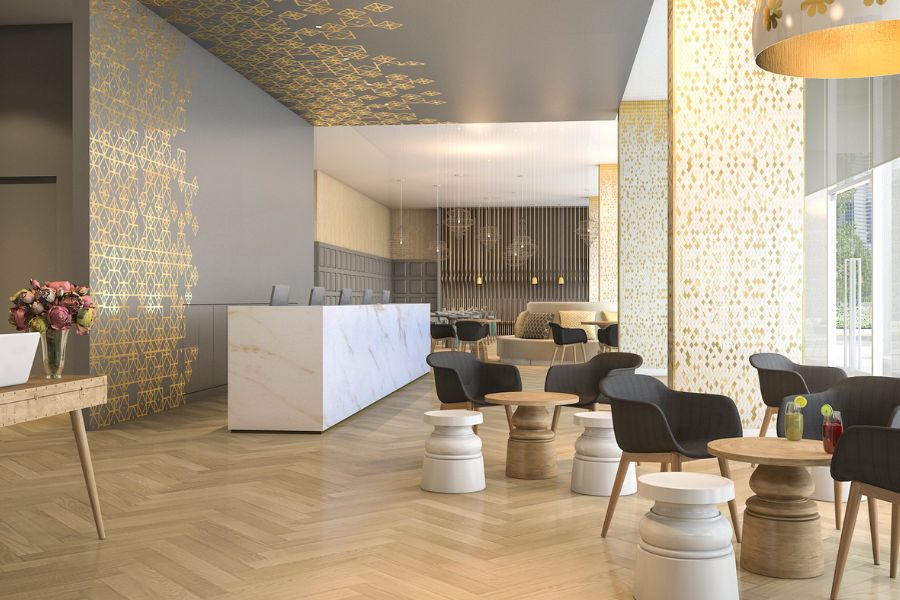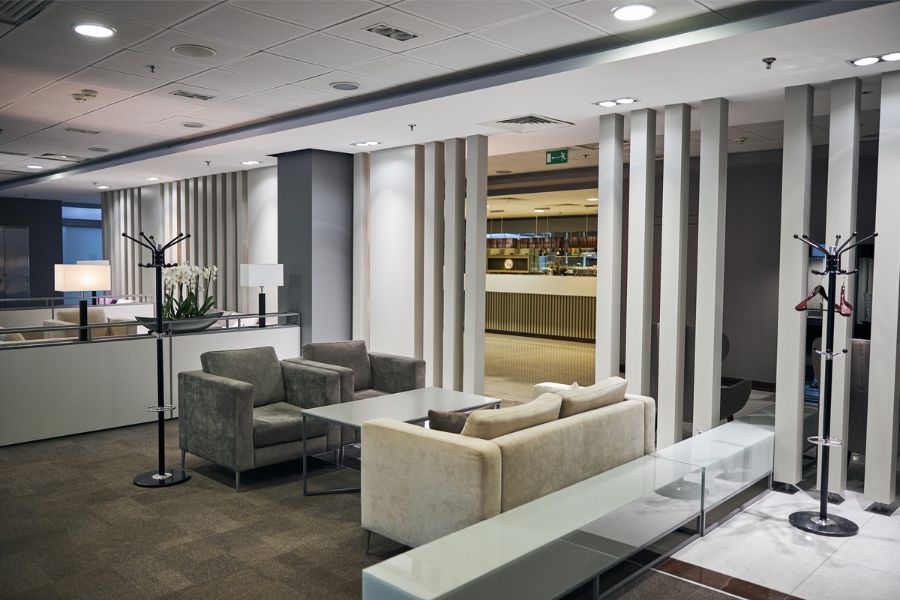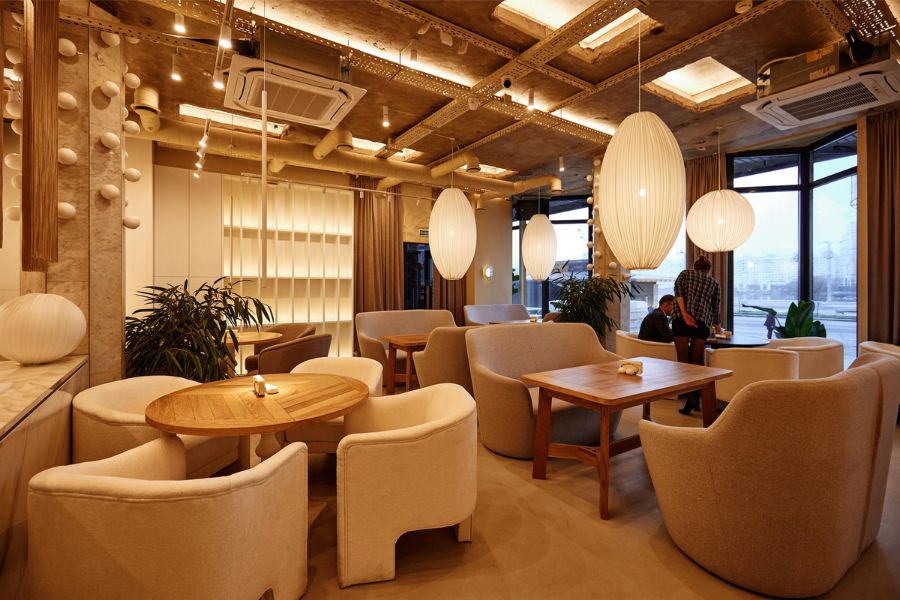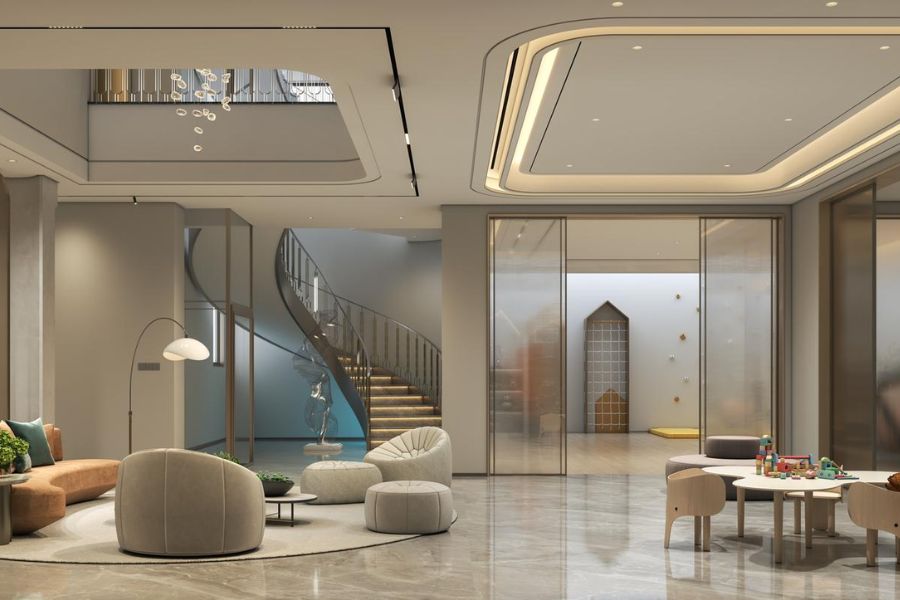Creating a Lasting Impression: The Role of Aesthetics in Commercial Architectural Design
“Architecture is the very mirror of life. You only have to cast your eyes on buildings to feel the presence of the past, the spirit of a place; they are the reflection of society.”
– I. M. Pei
Introduction

Aesthetics are crucial in establishing the identity and success of a commercial space in commercial architecture. Commercial architecture is about creating an experience, an ambience that connects with the brand and makes a lasting impression on anybody who walks through its doors. In this context, aesthetics become the language that communicates the essence of a business space. It’s not merely a matter of style; it’s about defining the very identity and success of the enterprise.
Modern commercial architecture has evolved beyond its conventional duty of providing shelter and functionality. It has evolved into an art form, a mix of creativity and purpose that elevates rooms beyond their physical limitations. Today’s Architects are similar to storytellers, weaving storylines through the elements they select, the colours they splash across walls, and how they handle space and light.
Understanding the tremendous impact aesthetics has on consumer perception is the starting point in investigating the significance of aesthetics in commercial architecture. Aside from a company’s concrete services, the visual appeal of its physical space is an essential aspect of attracting and retaining clients. It establishes the tone for the brand narrative by portraying professionalism, inventiveness, and a dedication to quality.

Furthermore, commercial building aesthetics is not a one-size-fits-all idea. It is a deeply psychological undertaking that explores people’s emotional reactions to their surroundings. Colour interplay, spatial flow, and overall design scheme can all elicit distinct feelings and moods. Architects study the psychology of aesthetics to create settings that appear nice and feel correct, enriching the entire visitor experience.
Innovative design businesses are at the forefront of incorporating cutting-edge technology and sustainable methods into their projects in the pursuit of excellence. The confluence of technology and aesthetics brings up new creative possibilities. Virtual reality simulations, parametric design tools, and other technical advances enable architects to push the frontiers of what is possible, resulting in truly innovative and visually spectacular creations.
Sustainability, too, has become a cornerstone in modern commercial architecture. Businesses are becoming more conscious of their environmental impact, and design firms are reacting by seamlessly incorporating eco-friendly strategies while maintaining the aesthetic integrity of their projects. The adoption of sustainable materials, energy-efficient technologies, and green construction methods is more than a passing fad; it represents a fundamental movement toward responsible design.

Case studies that exhibit real-world instances of spaces that have transcended the ordinary help us uncover the secrets underlying successful commercial architecture designs. These studies dig into design firms’ tactics for creating distinctive and memorable commercial structures, offering insight into the decisions and considerations that contributed to their success.
The selection of an architect for a commercial project is a key decision that can make or break the desired aesthetic impression. It entails reviewing a design consultancy’s portfolio, learning about their ideology, and assessing their ability to integrate technology and sustainability. This blog area will provide practical insights and ideas for navigating this decision-making process, ensuring that your project is in the hands of professionals who understand the delicate balance between aesthetics and practicality.
In essence, this site offers as a thorough reference to the diverse sphere of commercial architecture aesthetics. It understands that the design of a commercial space is a delicate balance of form and function, of visual appeal and utility. As businesses attempt to make a statement in an ever-changing market, the role of aesthetics in commercial design serves as a beacon, guiding the way to building environments that are experienced, remembered, and cherished rather than merely seen.
The Importance of Aesthetics in Commercial Architecture Design

In the dynamic and competitive landscape of business, commercial spaces are not merely physical structures housing transactions; they are living embodiments of a company’s brand identity and culture. The façade of a business location serves as a visual prelude to the narrative that unfolds within. It’s the first impression, a strong visual handshake extended to passers-by and prospective buyers.
The architecture speaks volumes about the character of the company, its personality, and its dedication to excellence. Every detail, from the materials used to construct the facade to the strategic placement of signage and lighting, contributes to the overall picture. The outside design communicates the firm’s essence to the world, whether it’s sleek, modern interior design trends signalling innovation or a classic and timeless style implying tradition.
When you go through the door, the interior design takes centre stage, allowing you to delve deeper into the brand’s identity. The total experience is influenced by the layout, colour palette, and overall mood, which shapes perceptions and emotions. A well-designed interior not only improves the space’s utility but also generates a distinct ambience that resonates with the target audience. It serves as a canvas for the company’s story, immersing customers in the brand narrative.
How Aesthetics Can Influence Consumer Perception

The visual characteristics of a commercial facility play a pivotal role in consumer perception, serving as the first handshake between a brand and its target audience. Customers instinctively assess a brand’s professionalism, credibility, and devotion to quality based on the ambience, colour scheme, and overall design. In this visually-driven age, a well-designed business space has the power to attract and retain clients, fostering a positive brand association.
The mood, colour scheme, and general design of a well-crafted corporate environment transcend basic aesthetics; they tell a narrative that resonates with clients. Incorporating modern design for large spaces and timeless luxury design ideas, businesses benefit from design consultancy for established enterprises, ensuring a visual identity that reflects expertise, credibility, and a commitment to quality.
A well-crafted corporate environment’s mood, colour scheme, and general design go beyond basic aesthetics; they tell a narrative that connects with clients. A well-designed location has the magnetic potential to attract and retain customers, providing a monument to the brand’s dedication to excellence. A visually appealing commercial location becomes a canvas on which a brand can paint its identity, making an indelible stamp on consumer consciousness and nurturing a favourable, enduring association.
The Psychology of Aesthetics in Architecture

Modern design with bold colours is a crucial aspect of building design psychology. Architects who understand aesthetic psychology leverage this concept to create spaces that go beyond mere visual appeal. The complex interaction between the built environment and human emotions is at the forefront of their design considerations. Colours, particularly bold and modern choices, are recognised as powerful tools to elicit specific psychological responses. Cool tones like blues and greens induce tranquillity, while warm tones like reds and yellows evoke vitality and warmth.
Moreover, lighting, whether natural or artificial, is acknowledged for its significant impact on mood, circadian rhythms, and overall well-being. Architects who integrate these principles into their designs aim to create settings that connect with people on a deeper emotional level. Spatial design elements such as openness, symmetry, and proportions are carefully considered to influence how individuals feel within a space.
Architects, with a keen understanding of aesthetic psychology, essentially transform structures into living, breathing entities that serve practical purposes while enriching the human experience within their walls. Recognising the psychological influence of architectural features, particularly in the context of modern design with bold colours, allows for creating environments that resonate with and enhance the well-being of those who inhabit them.
Elements of Aesthetic Design in Commercial Architecture

To stand out in a competitive market, modern commercial architecture frequently incorporates unique design aspects. Architects use a variety of features to create visually appealing and practical environments, ranging from cutting-edge facades to open-concept interiors. This section will look into some of these elements and how they contribute to the overall aesthetic appeal of commercial architecture.
Case Studies of Successful Commercial Architecture Designs

Understanding the practical application of aesthetic concepts in commercial design requires a close examination of real-world instances. We’ll look through the portfolios of design firms, highlighting projects that successfully mix form and function to create iconic commercial environments. These case studies will demonstrate the various techniques architects utilise to achieve aesthetic brilliance.
Godrej One, Mumbai –
Architectural Firm – Perkins and Will
Godrej One, the Godrej Group’s corporate headquarters in Mumbai, is a spectacular example of environmentally friendly and aesthetically beautiful architecture. The structure has green certifications, rainwater collection, and energy-saving measures. Perkins + Will’s design focuses on establishing a collaborative and employee-friendly environment through open layouts and greenery.
The Capital, Bandra Kurla Complex –
Architectural Firm – James Law Cybertecture
James Law Cybertecture’s Capital at Bandra Kurla Complex is a commercial property that combines innovative design with environmental characteristics. The building’s unique design, inspired by origami, and attention to energy efficiency set it apart in Mumbai’s financial centre.
Incorporating Sustainability and Aesthetics in Commercial Architecture

The increasing emphasis on sustainability has fundamentally altered the landscape of commercial architecture design. This section delves into the intricate balance achieved by design studios in implementing sustainable design practices without compromising aesthetic appeal. We scrutinise instances where architects seamlessly intertwine sustainability and visual attractiveness, showcasing real-world examples that serve as inspirational benchmarks.
These architects demonstrate ingenious approaches that reduce environmental impact and elevate commercial spaces’ overall appearance. From the incorporation of recycled materials to the implementation of energy-efficient systems and green building and sustainable design practices, these designs stand as beacons of inspiration for a new era of conscientious and visually captivating commercial architecture. By embracing sustainability without sacrificing style, design studios set a precedent for the integration of eco-friendly solutions into the aesthetic fabric of modern architectural design.
The Role of Technology in Enhancing Aesthetic Design in Commercial Architecture

Technology has transformed the world of architecture, providing a plethora of tools and novel ideas that push the frontiers of design. This section delves into the revolutionary impact of technology on the aesthetics of commercial architecture. Immersive experiences are provided via virtual reality simulations, allowing architects and clients to visualise spaces before they are built.
Advanced software enables metric design, which allows for the building of complicated and dynamic structures. These technology improvements not only improve the precision and efficiency of the design process but also enable architects to build visually attractive and innovative commercial environments. From digital modelling to interactive simulations, technology is a driving force in improving the aesthetics of modern commercial design.
The Impact of Aesthetics on Employee Productivity and Satisfaction

Commercial spaces function as both a consumer-facing setting and a backdrop for employee experiences, making workplace aesthetics essential to productivity and contentment. Studies and real-world experiences demonstrate the substantial relationship between office design and employee well-being. Employee morale, work happiness, and overall performance have all been demonstrated to improve in environments that are thoughtfully created with appealing aesthetics.
The strategic use of natural light, ergonomic furniture, and brilliant colours all contribute to a good and accommodating environment, generating a sense of pride and comfort among employees. We obtain significant insights into how investment in workplace aesthetics may convert into a more motivated, contented, and engaged staff by investigating these research and examples.
How to Choose the Right Architect for Your Commercial Project

The choice of an architect for a commercial project is critical to its success. In this part, we’ll present a complete checklist to help you make an informed decision when hiring a commercial design business. A careful analysis of a design studio’s portfolio will reveal information about its competence and design philosophy. Because technological integration is so important in today’s architectural world, we’ll look at how a firm uses cutting-edge tools and approaches to push the frontiers of design. By taking these factors into account, you can make an informed decision, guaranteeing that your selected architect shares your project’s vision and can provide unique, technologically advanced solutions.
Conclusion: The Lasting Impact of Aesthetics in Commercial Architecture Design

Finally, the aesthetics of commercial architecture design go beyond mere beauty; they impact perceptions, influence behaviour, and contribute to corporate success. Commercial spaces may leave a lasting impact on both customers and staff by recognising psychological elements, including sustainability, using technology, and hiring the right personnel.
The quest for aesthetic excellence is a constant journey in the dynamic world of commercial architecture, and those who embark on it with a thoughtful approach are positioned to create spaces that survive the test of time. Businesses, like their physical manifestations, must develop as well, and through the prism of aesthetics, these spaces become more than just structures but communicators of innovation, culture, and success.
Image Reference: Freepik
Disclaimer: All trademarks, logos, and brand names are the property of their respective owners. All company, product, and service names used in this website are for identification purposes only. Use of these names, trademarks, and brands does not imply endorsement.
